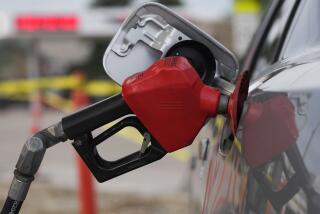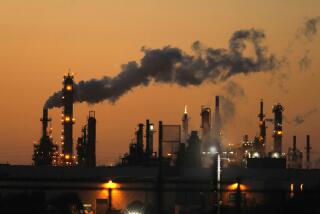Gas Prices Keep Dropping as Dealers Brawl
- Share via
California’s gasoline prices are dropping in defiance of seasonal logic as the Fourth of July weekend gets under way, the result of a glut and a bare-knuckled marketing brawl instigated by Chevron.
Dealers, refiners and others say the temporarily tight supplies that characterized local gasoline markets in April and May have given way to a flood of gasoline that promises to drive down prices still further in the weeks to come.
Service stations were still slashing prices Thursday in the Los Angeles area, even as holiday drivers took to the road. Normally, dealers can be expected to boost prices several cents a gallon in anticipation of heavy traffic on summer holidays.
By one estimate, Southern California prices have already dropped 4 cents a gallon from the 96.9-cent average for unleaded regular measured in the June 20 canvas conducted by the Lundberg Survey, the Los Angeles firm that tracks prices around the country. Prices as low as 85 cents for unleaded were not uncommon Thursday.
Added Cut in Sight
“I would think the metropolitan stations will hold the line on prices over the weekend, and then probably come down another 3 cents a gallon,” said Steve Shelton, executive director of the Southern California Service Station Assn.
“Of course, if you’re on the way to the Colorado River and there aren’t any other stations around, those guys are going to add a few pennies.”
In part, California’s declining prices mirror what has happened nationally over the last several days. Analysts have attributed the declines to lower-than-expected demand after refineries, expecting an explosion in driving because of the collapse in crude oil prices, had built up huge inventories of gasoline.
Those lower prices will tend to be perpetuated by renewed declines in crude oil prices triggered by this week’s failure of the Organization of Petroleum Exporting Countries to agree on a cutback in oil production.
However, the price declines in California--where motorists in April were paying as much as 15 cents a gallon more for gasoline than in other parts of the country--have been steeper than elsewhere. By this week, the price gap between Los Angeles and cities in the Midwest and East was down to 3 cents to 5 cents a gallon, according to the trade publication Oil Daily.
One reason is a glut created by an end to the California refinery problems that had been blamed for the tight supplies, as well as the delivery of hundreds of thousands of gallons of gasoline from tankers dispatched from Houston to take advantage of California’s higher prices.
Fueling the decline locally, according to several industry observers, has been a pricing attack by Chevron, the No. 2 gasoline marketer in the state, on Arco, which had been strengthening its No. 1 position in the nation’s largest gasoline market.
Since it abandoned credit cards and implemented other cost-saving steps in 1981, Arco had slashed prices and was able to leapfrog Chevron, Shell and Unocal in California. A typical price advantage of 5 cents to 7 cents a gallon over the others gave Arco 17.6% of the state gasoline market in the first four months of the year--a gain of about two percentage points over Chevron in a year’s time, according to Lundberg Survey figures.
Shell Displaces Chevron
Adding insult to injury, Chevron in April was displaced by Shell as the No. 2 marketer in the state, the Lundberg figures show. Unocal remained a close fourth.
Chevron executives play down what has happened since, but all of a sudden it is not unusual to see Chevron dealers undercutting Arco on price. And that has put additional downward pressure on all brands in the state.
“For about the last month, Chevron has been really competitive, and we’re selling the hell out of gas,” a Santa Ana Chevron dealer said. “I don’t know what the hell’s going on, but they’re really being good to us. And I’ve noticed Arco hasn’t been all that competitive lately.”
Indeed, this dealer said he is now 4 cents a gallon below his nearest Arco competitor.
James Childers, supervisor of price recommendations at Chevron U.S.A. in San Francisco, said that the only thing that has changed is the end of an alleged tax-related price advantage Arco got from its reliance on Alaskan crude oil. That controversial advantage, which Arco dismisses as a reason for its price leadership, has disappeared, along with the windfall profit tax as a result of plummeting prices of crude oil.
‘Free Marketplace’
“Perhaps Arco doesn’t have the ability to be as aggressive as they used to be,” Childers said. “Now we’re on equal footing. Perhaps you’re seeing the free marketplace at work.”
Childers would not discuss Chevron’s pricing actions, but an Arco spokesman speculated that Chevron is offering incentives to dealers who sell a lot of gasoline in a market that is clearly heating up.
“They’re good marketers, and people are buying a billion gallons a month. It’s a bigger pie, and everyone is scrambling for part of it,” the Arco official said, referring to sharp increases in California gasoline sales this spring.
Shelton, whose trade group is made up largely of owners and operators of major-brand service stations, said Chevron has become “much more aggressive and is putting a lot of pressure on dealers. They’re both giving up some pennies and some of the more aggressive dealers are undercutting Arco. Chevron would like to reestablish itself as the dominant marketer on the West Coast.”
Added an industry analyst who requested anonymity: “Arco’s been eating away for so long on Chevron’s monthly share, I think Chevron’s had enough.”
More to Read
Inside the business of entertainment
The Wide Shot brings you news, analysis and insights on everything from streaming wars to production — and what it all means for the future.
You may occasionally receive promotional content from the Los Angeles Times.










